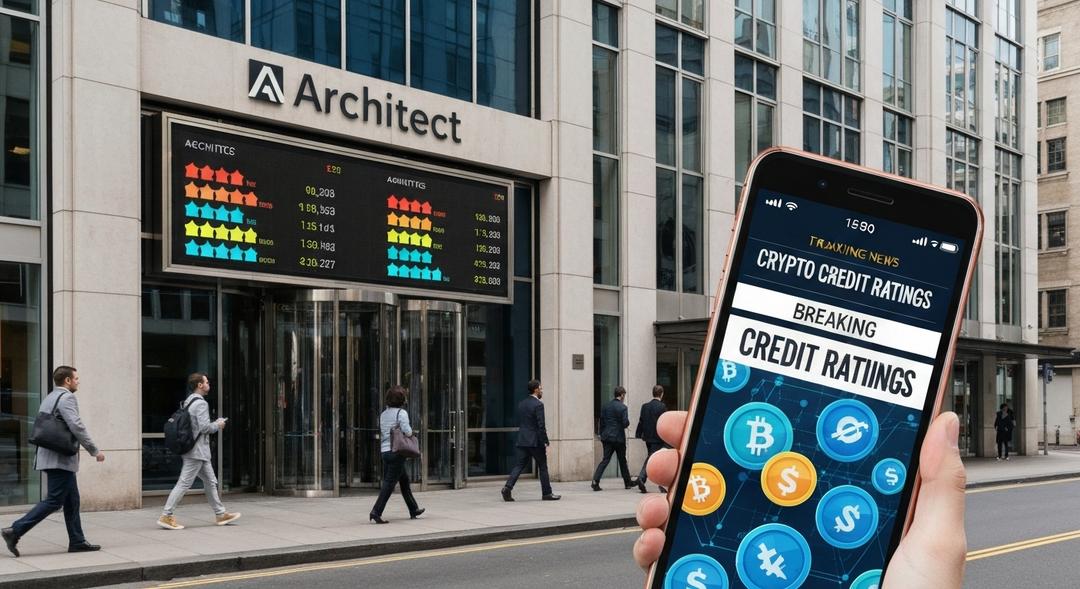Institutional investors are searching for credible ways to assess risk. The evolution of digital assets and decentralized finance now makes this necessity especially clear.
Digital assets are quickly maturing, but one cornerstone of traditional finance is still absent. Most sectors rely on trusted agencies to evaluate creditworthiness, but in crypto, this practice has yet to fully take hold.
With anonymous market participants and unconventional data, crypto markets have posed new challenges for risk evaluation. Lenders often hesitate to provide debt financing, stalling broader access to capital.
Architect is making moves to address this missing piece. Their new institutional credit ratings service stands out by tailoring assessments exclusively for digital assets.
Traditional rating agencies such as Moody’s have experimented with entering the crypto space. But the vast majority have stopped short of offering a full-scale credit rating system for digital assets. This leaves a sizable gap for a dedicated agency to fill.
Ruben Amenyogbo, Managing Partner at Architect, explains that crypto’s lack of an impartial credit intermediary makes institutional lending difficult. The sector’s unique structure has forced many lenders into a holding pattern.
Publicly traded companies with a focus on cryptocurrency have tried to fill this void by offering investors equity exposure. However, this corner of the market is approaching saturation. Many analysts now argue that these crypto-related equities are overvalued as cash continues to chase limited opportunities.
Amenyogbo believes that these trends open the door for credit to rise as the next major opportunity. He points out that without robust credit assessment tools, the market’s risk evaluation remains incomplete.
Architect’s platform plans to systematically examine credit risk using proprietary blockchain-based data. The emergence of reliable blockchain records now enables meaningful backward-looking assessments.
While the equity market encourages bets on future growth, credit requires a different analysis. It demands evidence of consistent performance and solid repayment history. The industry’s rapid maturation has only recently created enough data to support such methods.
Both bitcoin miners and decentralized infrastructure networks, known as DePIN, stand to benefit from this shift. With credit access, bitcoin miners could reduce the need to sell assets under pressure, and instead leverage those assets more productively within the crypto economy.
This transition could drive increased on-chain activity and real economic contributions rather than merely adjusting to market prices. Lenders may prefer this logic, betting on cash flows and operational success rather than price speculation alone.
Decentralized Physical Infrastructure Networks are also seen as an underutilized area for credit growth. Unlike pure speculative plays, these networks deliver tangible economic value that lenders and investors can assess more objectively.
The long term vision for Architect stretches far beyond single investments. Amenyogbo describes an ambition to define and scale the entire credit market for digital assets with the same depth and rigor found in traditional finance.
Rather than focusing solely on new loans, the ultimate goal is to structure, rate, and bundle credit products so they can be syndicated into large pools of institutional capital. This would allow crypto markets to function with a degree of reliability and access that equity-focused strategies have struggled to provide.
The timing is significant, as the broader market landscape continues to shift. Bitcoin remains above $114,000, and while short term trading opportunities persist, analysts are watching volume and broader patterns closely.
Ethereum has experienced some downward pressure, currently trading around $3500 as certain funds move out of ETFs. Traditional markets also reflect uncertainties, with gold dipping on a stronger dollar and mixed economic signals from Asia and the United States.
The investment community is closely watching regulation as well. Recent statements from the SEC affirm that certain liquid staking products do not violate securities laws. Meanwhile, retail investors in the Ethereum ecosystem remain more cautious, even as institutional activity continues to climb.
Amid these dynamics, platforms offering new infrastructure around Start Cloud Mining are growing in appeal. By enhancing transparency and reliability, these services help bridge the gap between emerging digital assets and seasoned institutional investors.
For decentralized networks and miners, gaining access to structured lines of credit may enable a shift from reactive to proactive economic participation. In this way, access to credit becomes more than a financial product — it becomes a vital part of digital finance infrastructure.
Conclusion
The introduction of institutional grade credit ratings within the cryptocurrency sector marks a turning point. These new services aim to support sustained growth by providing structure where it was lacking.
By applying trusted credit evaluation methods and adapting them for decentralized technology, firms like Architect hope to unlock broader participation and new capital inflows for the digital economy. The future of crypto may depend as much on financial foundations as on technological innovation.

Ewan’s fascination with cryptocurrency started through his curiosity about innovative technologies reshaping the financial world. Over the past four years, he has specialized in cloud mining and crypto asset management, diving deep into mining contracts, profitability analysis, and emerging trends. Ewan is dedicated to helping readers understand the technical and economic aspects of crypto mining, making complex information accessible and actionable.




